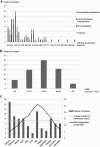Undercorrection of hypernatremia is frequent and associated with mortality
- PMID: 24559470
- PMCID: PMC3939641
- DOI: 10.1186/1471-2369-15-37
Undercorrection of hypernatremia is frequent and associated with mortality
Abstract
Background: About 1% of patients admitted to the Emergency Department (ED) have hypernatremia, a condition associated with a mortality rate of 20 to 60%. Management recommendations originate from intensive care unit studies, in which patients and medical diseases differ from those in ED.
Methods: We retrospectively studied clinical characteristics, treatments, and outcomes of severely hypernatremic patients in the ED and risk factors associated with death occurrence during hospitalization.
Results: During 2010, 85 cases of severe hypernatremia ≥ 150 mmol/l were admitted to ED. Hypernatremia occurred in frail patients: mean age 79.7 years, 55% institutionalized, 28% with dementia.Twenty four percent of patients died during hospitalization. Male gender and low mean blood pressure (MBP) were independently associated with death, as well as slow natremia correction speed, but not the severity of hyperosmolarity at admission. Infusion solute was inappropriate for 45% of patients with MBP <70 mmHg who received hypotonic solutes and 22% of patients with MBP ≥ 70 mmHg who received isotonic solutes or were not perfused.
Conclusions: This is the first study assessing outcome of hypernatremic patients in the ED according to the treatment provided. It appears that not only a too quick, but also a too slow correction speed is associated with an increased risk of death regardless of initial natremia. Medical management of hypernatremic patients must be improved regarding evaluation and treatment.
Figures

References
-
- Arampatzis S, Exadaktylos A, Buhl D, Zimmermann H, Lindner G. Dysnatraemias in the emergency room: Undetected, untreated, unknown? Wien Klin Wochenschr. 2012;124(5–6):181–183. - PubMed
-
- Arampatzis S, Frauchiger B, Fiedler GM, Leichtle AB, Buhl D, Schwarz C, Funk GC, Zimmermann H, Exadaktylos AK, Lindner G. Characteristics, symptoms, and outcome of severe dysnatremias present on hospital admission. Am J Med. 2012;125(11):1125. - PubMed
-
- Fall PJ. Hyponatraemia and Hypernatremia (a systemic approach to causes and their correction) Postgrad Med. 2000;107(5):75–82. - PubMed
-
- Oufella H, Offenstadt G. Troubles de l’équilibre acido-basique et désordres hydro-électrolytiques. La revue du praticien. 2003;53:883–892. - PubMed
MeSH terms
LinkOut - more resources
Full Text Sources
Other Literature Sources
Medical
Miscellaneous

